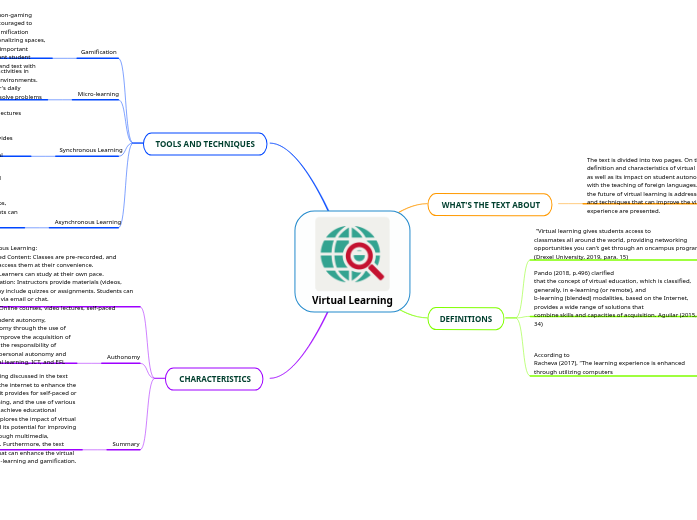
Virtual Learning
WHAT'S THE TEXT ABOUT
The text is divided into two pages. On the first page, the definition and characteristics of virtual learning are discussed, as well as its impact on student autonomy and its relationship with the teaching of foreign languages. On the second page, the future of virtual learning is addressed, and some tools and techniques that can improve the virtual learning experience are presented.
DEFINITIONS
“Virtual learning gives students access to
classmates all around the world, providing networking opportunities you can't get through an oncampus program.” (Drexel University, 2019, para. 15)
Pando (2018, p.496) clarified
that the concept of virtual education, which is classified, generally, in e-learning (or remote), and
b-learning (blended) modalities, based on the Internet, provides a wide range of solutions that
combine skills and capacities of acquisition. Aguilar (2015, p. 34)
According to
Racheva (2017), “The learning experience is enhanced through utilizing computers
What kind of stuff could we use for use TIC's?
Camara
Computer
Phone
Tablet
Microphone
TOOLS AND TECHNIQUES
Gamification
Involves applying game design principles in non-gaming contexts, such as education. Teachers are encouraged to design, implement, manage, and optimize gamification strategies to achieve educational goals. Personalizing spaces, learning, and exploring topics of interest are important aspects of gamification, as it enhances different student capacities by relating images with meanings and text with experiences
Micro-learning
This approach focuses on designing learning activities in small, manageable steps within digital media environments. These activities can be integrated into a learner's daily routine, encouraging the use of technology to solve problems and prioritize task performance
Synchronous Learning
- Real-time Interaction: Students attend live online lectures where instructors present material. Students can ask questions via webcam, microphone, or chat.
- Interactive Experience: Synchronous learning provides immediate interaction and engagement.
- Examples: Webinars, live video conferences, virtual classrooms.
Asynchronous Learning
- Pre-recorded Content: Classes are pre-recorded, and students can access them at their convenience.
- Flexibilit: Learners can study at their own pace.
- Communication: Instructors provide materials (videos, notes) and may include quizzes or assignments. Students can communicate via email or chat.
- Examples: Online courses, video lectures, self-paced modules
CHARACTERISTICS
2. Asynchronous Learning:
- Pre-recorded Content: Classes are pre-recorded, and students can access them at their convenience.
- Flexibilit*: Learners can study at their own pace.
- Communication: Instructors provide materials (videos, notes) and may include quizzes or assignments. Students can communicate via email or chat.
- Examples: Online courses, video lectures, self-paced modules
- Pre-recorded Content: Classes are pre-recorded, and students can access them at their convenience.
- Flexibilit: Learners can study at their own pace.
- Communication: Instructors provide materials (videos, notes) and may include quizzes or assignments. Students can communicate via email or chat.
- Examples: Online courses, video lectures, self-paced modules
Authonomy
The impact of virtual learning on student autonomy, emphasizing how it promotes autonomy through the use of various tools and options that help improve the acquisition of foreign languages. It also highlights the responsibility of foreign language teachers to foster personal autonomy and the close relationship between virtual learning, ICT, and EFL (English as a Foreign Language)
Summary
The characteristics of virtual learning discussed in the text include the use of computers and the internet to enhance the learning experience, the flexibility it provides for self-paced or live web-conferencing online teaching, and the use of various platforms and web applications to achieve educational objectives. Additionally, the text explores the impact of virtual learning on student autonomy and its potential for improving educational quality at all levels through multimedia, hypertext, and interactive features. Furthermore, the text presents future trends and tools that can enhance the virtual learning experience, such as micro-learning and gamification.
